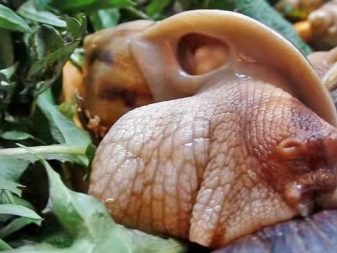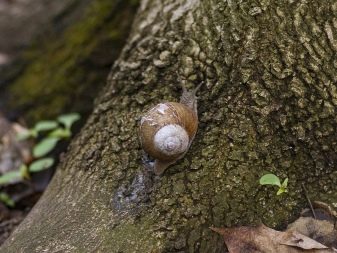Today snails are very popular among fans of unusual pets. This unpretentious gastropod does not need a specially designed diet. It is believed that if this mollusk is an exotic animal, it means that you need to feed it with almost exclusive products. But this is not the case. In this article we will talk in detail about what the snail eats, what it can be given, and which foods are strictly prohibited for consumption.


Nutrition in nature
Like any other living creature, be it cold-blooded or warm-blooded, the snail was originally born in wildlife. Only at the expiration of time the mollusks began to breed and maintain at home, as well as to teach them to other food. Snail is a herbivorous gastropod mollusk. After lengthy observations and studies, experts concluded that in nature the diet of snails consists of grass, leaves, vegetables, fruits, and tree bark.


Nutrition depends on age: young mollusks prefer fresh foods in the diet, while adults prefer rotten fruits.
A delicacy is the bark of a decayed tree.
Let's look at each type of snail and find out what kind of food in nature is characteristic of it.
- Ground (land). These include Achatina, grape snail and ordinary street. In nature, they feed on living vegetation and various plant debris. The most popular foods include grape leaf, wild strawberry, cabbage, nettle, burdock, dandelion, plantain, radish. Among such mollusks there are also predators who are not averse to eating insects.

- Marine. These snails can eat various foods - algae, fresh root crops and fruit plants.

- River. The clam feeds on the same foods and plants as the clam.

What can I give at home?
This question is very relevant for those who decide to have such a pet, but do not know anything about what they eat.
Of course, diet and proper nutrition are very important and are of great importance for the active growth and healthy development of the cochlea.
The most popular decorative snails found at home are Achatina. Their diet includes plant food, namely:
- vegetable crops - cucumber, zucchini, boiled potatoes and onions, pumpkin;
- fruits - strawberries, pears, apples, melon;
- legumes - lentils;
- cereals - barley, oatmeal, corn and barley porridge, buckwheat and rice;
- greens;
- sunflower and flax seeds;
- foliage of such trees as eucalyptus, birch, oak, linden;
- various berries;
- mushrooms are exceptionally fresh.


This mollusk also needs food containing calcium (a mineral supplement).
- Feed chalk - This is the most affordable top dressing, which is sold at a pet store or veterinary pharmacy at an affordable price.

- Sepia - cuttlefish shell, consisting of 35% of calcium, it can be purchased at a specialized outlet. It goes on sale by the piece. If the carapace is quite salty, then before giving it to the snail, rinse under warm water to wash off excess salt;

- Shell rock - This is a crushed river or sea shell. This type of mineral supplement is not in demand, since the mollusk is not very convenient to eat. When buying, you need to carefully read what the manufacturer writes on the package. The product should be 100% shell rock, without any other additives and impurities. It contains 40% calcium.

- Eggshell - It is the most natural and natural source of calcium and other beneficial vitamins and minerals. A small snail can be fed a shell egg from which it hatched; an adult can be fed a shell quail or chicken egg. The shell must be raw, since the boiled contains two times less calcium.

It must be washed, cleaned of the film, dried and ground with a coffee grinder.
Snails need achatin and protein. It can be of animal origin and can be found in fish feed, meat and bone meal and crustaceans - gammarus, daphnia. The snail will receive plant-based protein by eating cereals (except semolina), mushrooms, nuts (except peanuts), fruit drying, seeds and bran.
There are a few helpful tips to consider.
- Remember, all plant products that you plan to give the snail should be fresh and preferably natural, and not from the supermarket. Of course, if you do not have your own land with beds, then buy products, but wash them well before use.
- Calcium is very important for the snail. The formation of the shell depends on it. The condition and health of the shell is extremely important, because it is not only a part of the mollusk's body, but also an external skeleton. If the sink is not strengthened and not taken care of, the worst can happen - the shell will start to hurt and the animal will die. In the natural environment, the snail itself finds food that is rich in calcium, but when it lives in an aquarium, special mineral additives are the source of calcium for it. Mineral supplement is a kind of top dressing, which is mandatory for gastropod mollusk.
- It is strictly forbidden to feed the gastropod with chemicals that supposedly contain calcium. It is also not recommended to use school or construction chalk, mineral stones for birds and complex mixtures as top dressing. All of these additives will harm the clam. The ideal option is to buy a special feed chalk in a veterinary pharmacy or specialized outlet.
- Protein foods are also important.If the mollusk does not consume enough of them, then its growth activity decreases.
- A snail loves a fruit like a banana, but it is not very healthy for her health. You can pamper the animal with bananas, but no more than 2 times a week.
- The diet of the snail should contain protein, which can be plant and animal.

As you can see, the list is very diverse, almost all food products are in the public domain and can be easily purchased.
Grape snail feeding
The ration of such a gastropod is very diverse. It is saturated with vegetables, fruits and various plants. A land snail diet is hard to imagine without the following products:
- fresh cucumbers;
- cabbage;
- salad;
- zucchini;
- apples
- carrot;
- leaves of grape, dandelion, plantain, burdock.
Calcium supplementation is very important. In order for the grape snail to receive the necessary dose of protein, it needs special mineral supplements.

Despite the fact that flour products are not recommended for use, these gastropods are very fond of fresh soaked bread.
You can treat a gastropod with such a delicacy, but not often and not in large quantities.
Food for aquarium (marine) mollusk
In most cases, an aquarium snail belongs to the family of vegetarians, but a predator, helena, can also be caught. The vegetarian at home eats plaque that covers the walls of the tank and feed the fish. And carnivorous helena can eat its own kind. Other types of mollusks - physa, melania, shells, are excellently suited as food for an aquarium animal. And you can also feed an aquarium snail with boiled meat of shrimp, squid or mussels.

Snail food
The first thing I want to say is that if you decide to have just such a pet, you should buy a separate tank for it. It is strongly not recommended that she live in the same aquarium with fish.
The thing is that the mollusk can be a carrier of various dangerous parasites. You can feed him a pond, shell rock, and also go to food and other mollusks.
All these food products for the gastropod can be collected on the river. They can also be fed with chopped vegetables.

Newborn food
Newborn snails eat differently, not like adults. In the first few days of life, they eat the shell from which they hatched. This is their basic food for the first time. Young animals need to be fed foods that contain a lot of calcium and vitamin D3. This vitamin will strengthen the baby's health and make him strong. As a top dressing for a newborn gastropod, a mineral mixture is suitable.
The main rule when feeding newborn snails is no soft food.
The thing is that due to her inexperience, the baby, when examining new food, can dig into it and suffocate. Therefore, it is best at first to treat the little street with herbs, herbs and finely chopped vegetables and fruits.

Prohibited Products
A gastropod creature living in the wild chooses its own food. But at home, the owner is already monitoring the diet and proper nutrition of the snail.
Based on observations and experience, we can conclude that the mollusk will eat absolutely everything that will be given to it.
But here a problem may arise, because there is a whole list of products that are forbidden to him.
The snail cannot be fed the following foods:
- food that contains a large amount of salt;
- flour products - such food is very hard for her;
- food seasoned with spices;
- raw potatoes, as it contains a large amount of starch;
- pork and lamb meat;
- rich products with a lot of sugar;
- pickles, smoked meats;
- citrus fruits as they destroy the mollusk shell;
- country berries;
- nightshade crops;
- fatty dairy products;
- specific plants (with a pungent smell and taste) - radish and ginger, sorrel and radish, onion, wormwood and hot pepper.


Feeding rules
It is worth considering how often you need to feed the snail. This issue is as important and relevant as others that are related to caring for animals. There is an opinion that a clam is quite enough one meal a week, but it is erroneous.
If you feed once a week, he will simply survive, but his growth and development will stop, the intensity of reproduction and the duration of life will decrease.
The following simple rules for feeding a gastropod should be followed:
- give food preferably once a day, in the evening; It’s no secret that ordinary mollusks that live in a special reservoir lead an active lifestyle in the evening, and during the day they often sleep;
- products should not be cold - ideal when they are slightly warmed up;
- put food on a special plate, not on a substrate; if not everything is eaten, it is necessary to remove the leftovers - the animal should not eat what has deteriorated;
- do not forget to put a shallow water tank in the aquarium; the snail, like other living things, needs fresh water, preferably at room temperature; you need to pour it very little, about 1 centimeter, so that the inhabitants do not drown;
- if snails live in the same aquarium with fish, then you need to feed them when the fish are full or sleeping, otherwise the food will not get into the clam - the fish will quickly eat everything.

Remember that small gastropods eat much less than large, so they often do not need to be fed. And of course, before deciding on how to feed your unusual pets and in what quantities, consult a specialist - a professional will tell you what is best for your pets, which diet will support their health and allow you to live a maximum period.
Adhering to these feeding rules and recommendations from specialists, you can be sure that your pet will grow happy, satisfied and full.
But only if you buy products in a store, spend your time, but make sure they are fresh and usable. If possible, heat them before giving them to snails.
What feed domestic snails, see below.










